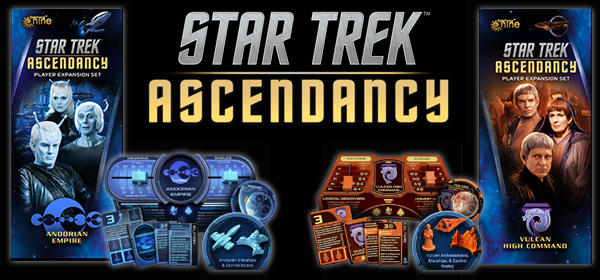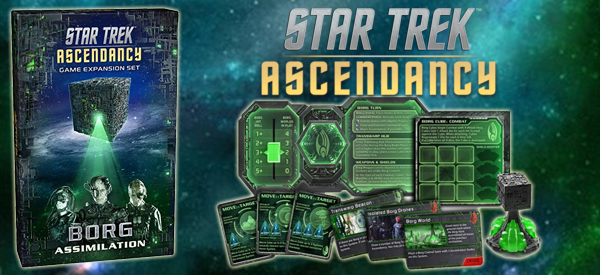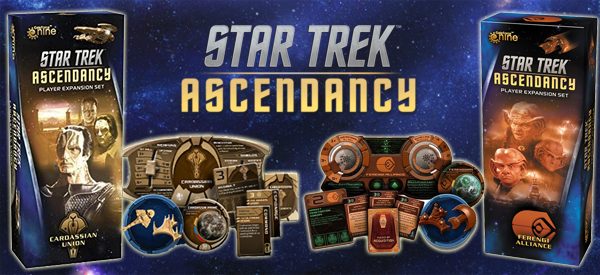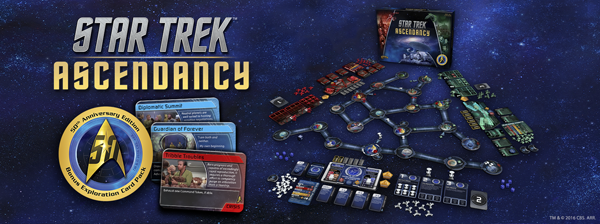
Star Trek: Ascendancy must be a more popular game than I thought. Usually I think of Star Trek games as being pretty niche and unlikely to find widespread success. But Ascendancy must be doing well because 8 years later, Gale Force 9 is still pumping out expansion packs and new accessories. Ascendancy deserves it. It's a fantastic game! In fact, it might very well be my favorite tabletop game at the moment.
The Vulcan and Andorian expansions were both released a few years ago, in 2019. But I couldn't review them near their release because I hadn't had an opportunity to play either of them until this past year or so. That's partly due to the fact that Gale Force 9's distribution isn't the best. The expansions were delayed several times, and my pre-orders were also late arriving. By the time I finally had them both, schedules just weren't favorable for playing. I had an opportunity to play with either faction within a few months of purchasing them, but we ended up sticking with the Ferengi and Cardassians.
We expected to play again soon and break in the Andorian and Vulcan sets, but then COVID happened. Ascendancy wasn't the only victim, as several other games (including Bloodborne, Tapestry, and U-Boot) have also sat un-opened or un-played since the summer of 2019.
Several games (or expansions) have sat un-opened or un-played since 2019 and 2021 thanks to COVID.
Now, GF9 has released another pair of expansions in 2022, with the Dominion War and Breen. This time, I didn't want to wait and risk letting them sit un-played for another 2 or 3 years, so we made sure to find time to play. Though reviews were still very late because I had 4 expansions to play and review instead of just 2. Which means it took quite a few play sessions to play everything and get a decent feel for it all.
It certainly helped that I introduced the game to some new players in the year or 2 following COVID, and they all loved it. I've now played with all the new factions and have impressions on all of them. I'll discuss the Dominion in a separate post, since the Dominion is a lot more complicated than simply being a new faction. It includes new rules for the Bajoran wormhole, Gamma Quadrant systems, and also includes a team variant game mode based on the Dominion War of Deep Space Nine. So for now, I'm going to cover the Andorians, Vulcans, and Breen.
Pre-Federation factions
The pair of 2019 expansions were both themed around Star Trek: Enterprise, offering versions of Federation-member cultures that represent their pre-Federation empires. I have to say, I was very surprised to see these factions be announced. Partly because they are both members of the Federation, and so don't seem like "big enough" galactic powers to warrant their own factions. To me, it seemed comparable to seeing the Virginia Commonwealth or Republic of Texas show up as a playable civilization in Sid Meier's Civilization.
But it was also a confounding release because I was expecting to see the Tholian faction that was promised by the base game's "Crystalline Entity" exploration card. I would have expected to see factions like the Dominion, Tholian, Gorn, or maybe even a Delta Quadrant faction like the Hirogen or Kazon, before seeing the Vulcans and Andorians show up as factions. Nevertheless, both introduce novel new gameplay mechanics and concepts, and show the development team at Gale Force 9 is getting quite creative with its faction concepts. [More]
c8602238-1f38-43f7-b62e-db5a7d8d9a68|0|.0
Tags:Star Trek, Star Trek: Ascendancy, Gale Force Nine, board game, expansion, Vulcan, Andorian, Breen, Dominion, lie, ambassador, research, isolationist

One of the weaknesses of Star Trek: Ascendancy (in my opinion) is the simplicity and irrelevance of the game's "minor races". They just sit there waiting to be invaded or hegemonized. They don't even have ships in orbit to defend themselves from attack (or provide the Klingons with an opportunity for some easy culture). I had hoped that there'd be an expansion pack that would give at least the warp-capable civilizations a little bit of agency. Sadly, that hasn't happened yet, but Gale Force 9 has released an expansion that does add an NPC faction: the Borg.
How do Borg allocate damage between multiple fleets?
The Borg are not a player faction (like the excellent Cardassians or Ferengi expansions). The Borg are a non-player "A.I." entity that use a deck of cards to define their behavior. They act in opposition to every player in the game, and are intended to add some extra player-versus-board challenge. The Borg expansion also adds rules for solo and 2-player games, though I'm not terribly happy with how either of those variants plays.
The big problem is that the rules for the Borg cause a lot of confusion. The non-player element of the Borg creates a lot of strange edge cases that the rulesmakers just didn't seem to think through very thoroughly. Some rules leave the Borg's actions somewhat ambiguous, and there are no rules for determining how to resolve such situations. For example, if a Bog cube is battling multiple fleets belonging to the same player, how does it determine which fleet takes damage? We generally house-rule that the Borg attack the largest fleet first, and that the player who activated the cube decides any ties.
The enemy of all my enemies
The bigger problem, however, is that the Borg movement rules lead to considerable balance issues once the Borg are connected to one player, because that poor player now faces the brunt of the entire Borg Collective. Once the Borg have a path to any one player's systems or homeworld, the Borg will exclusively funnel all of their ships down that one path, since it's the only "connected" route available. The only way this will change is for the targeted player to go out of his or her way to try to create another, shorter path to one of the other players (essentially painting a huge target on that player's head). Or I guess one of the other players could accidentally create a shorter path while they're exploring, if they're dumb or not paying particularly close attention. In any case, the problem is that once the Borg become connected to any one player, the Borg stop exploring and looking for the other players, which randomly puts the single player in a disadvantaged defensive position while the other two players are free to build up without much threat of being targeted by the Borg.
Having the Borg in play gives further reason for players to cooperate.
The game tries to offset this by making it so that the Borg become more powerful if they assimilate any worlds (including warp-capable civilizations), or if they assimilate any one player. If your homeworld is assimilated by the Borg, you even get to take over as a Borg player, taking a whole extra Borg turn in which you get to influence how they behave. This is a fun and thematic way of allowing an eliminated player to continue to participate in the game and seek some degree of "revenge" against the other player.
The idea here is that the players shouldn't let the Borg concentrate on wiping out a single player, and we should all partially co-operate in order to keep the Borg in check. There is no actual co-operative victory, so you're only co-operating with each other to the ends of stalling the Borg long enough for you to achieve a victory, at the expense of the other players. There is no "defeating" the Borg.
... [More]

It took forever for me to get a chance to play Star Trek: Ascendancy, thanks in large part to its hard three-player limit. I had a feeling that I would really enjoy the game when I first opened it up and skimmed through the rules. A good Star Trek-themed 4-x game is something that I've been craving since Birth of the Federation on Windows 98. Sure enough, after playing Ascendancy, it immediately became my favorite Star Trek board game on the market. The friends that I've played it with have also all loved it so far.
The base game included an insert advertising the first two expansions: the Cardassians and Ferengi. After the first play-session, I put the two expansions on my wishlist. Each expansion adds an additional faction and support for an additional player (for up to five, if you have the friends and the time). The Borg expansion came out around the same time, and I picked that one up too, as I was curious to see how the NPC Borg faction would play out. We decided to stick with the more basic expansions first though, as the Borg added extra complexity (and difficulty) that we weren't sure we were ready for. So I'll be reviewing the Borg seperately.
Star Trek: Ascendancy came packaged with an insert for the Cardassian and Ferengi expansions.
I had hoped to get a review of the Ferengi, Cardassians, and Borg out last year. And I don't mean like "in December" last year; I mean I had hoped to have this review out last February! Unfortunately, the difficulty inherent in getting four or five people together to play a six-hour board game, combined with packing up the house and moving last summer, meant that I got a couple early games in with the Cardassians, but never got a chance to play as the Ferengi until this winter. I didn't want to write a review of one faction without playing the other, since they are kind of inversions of each other in many ways.
The core game comes packaged with turn order cards for up to ten players, so I initially guessed that meant that Gale Force 9 was anticipating at least seven expansions. The Vulcans and Andorians will be released imminently, and the Borg rules actually allow the Borg to use up two turn order cards, which means there's only one space left to fill! Judging by the cards present in the base game, it looks like the Tholians are set to be the last expansion. If that's the case, this would leave some significant players on the Star Trek galactic stage out in the cold. The Dominion would be the single, most conspicuous absence from the game's roster. I also had hoped to see the Gorn as a faction, and at least one Delta Quadrant faction (such as the Kazon or Hirogen).
Well, I can take a guess what the next (hopefully not last) planned expansions is...
Though, I guess there's nothing stopping Gale Force 9 from releasing more expansion factions than there are turn order cards. I mean, I doubt anybody's going to be playing this game with nine or ten players anyway. Good luck finding a table big enough to even play such a game to begin with! GF9 could also just package an eleventh or twelfth turn order card in any future expansions if they feel it's necessary. So there's no reason why they would be unable to release the Dominion, Gorn, or other factions.
In any case, the first three expansions complete the Birth of the Federation roster of playable Federation, Klingons, Romulans, Ferengi, and Cardassians, as well as an NPC Borg faction.
There's not much in the way of new rules for either of the new factions. Both come with 10 new system discs (including the faction's respective homeworld), all the faction's ships and control nodes, advancement decks, some extra resource nodes and tokens, and ten new exploration cards. Everything slots pretty seamlessly into the core game. The only new mechanics are associated with some of the new exploration cards in the Ferengi expansion, but the card texts are pretty self-explanatory. There's a tiny rules insert anyway, in case you need more clarification.
I was expecting a Dominion expansion, and had hoped for the Gorn and at least one Delta Quadrant faction.
The seamless integration and lack of new rules does not, however, mean that the new factions feel dull or uninteresting. In fact, both the Cardassians and Ferengi have a very distinct (and very fresh) feel of play. Both have very potent unique boons and banes that separate them tremendously from the three factions included in the core set. In general, they both are dependent on using their ships and fleets to fuel their respective economies, which gives their ships uses beyond just exploration, research, and military action. You have to be very deliberate with your ships and fleets, since proper use is essential to keeping your economy running. As such, I don't recommend that a novice player jump into playing as either the Cardassians or Ferengi. You could probably muddle your way along, but it's better to have a firm grasp of the game mechanics (playing as the Klingons or Romulans) before you try your hand at the expansions.
... [More]
8ba34ba0-cafd-4866-80a3-5fab9c90eeb7|0|.0
Tags:Star Trek, Star Trek: Ascendancy, Gale Force Nine, board game, expansion, Cardassian, Ferengi, labor camp, production, occupation, invasion, trade, culture
Although the components for Gale Force Nine's Star Trek: Ascendancy are generally pretty exceptional (and the expansion components are also quite high quality), I did have one major disappointment with the package: the game does not include plastic figures to represent the various faction's starbases. Instead, the game uses cardboard tokens to represent starbases. These are functionally fine, but they just don't have the presence on the board to match their strategic importance within the actual game, and it's easy for them to kind of disappear into the background of the game's map. The individual cardboard tokens don't even have art specific to each faction; all five factions have pictures of Federation starbases on the top.
The manufacturer was apparently aware of this, and, in addition to selling "expansions" containing additional ships and control nodes for each faction, they also sell a set of three plastic starbase figures for each faction.
All factions use carboard tokens for starbases, all of which have pictures of Starfleet starbases.
Since I really like the Ascendancy board game, I wanted to support the manufacturer and designers. I had already purchased all three of the game's expansions (the Cardassian faction, Ferengi faction, and Borg: Assimilation expansion), and I'll be playing and reviewing them soon. I also went ahead and bought the starbases. GF9's storefront wants $12 USD for each set of a faction's three starbase figures. That's a pretty steep price for components for a game that already costs $100 without any expansions. $12 times five factions comes to $60 (almost two-thirds the cost of the core game!). The core game's components are all pretty nice, as are the components for the Borg expansion, and the pictures of the bases looked pretty nice (even though they are unpainted). So I went ahead and made a purchase.
I was excited to have the new toys to play with -- I always like getting new games and toys. But when they showed up, a lot of that excitement was dashed. The product that had been delivered was substantially sub-par.
These are definitely not ready to be played with out-of-the-box...
Defects and poor quality
The Ferengi and Klingon bases were attached to plastic frames and had to be torn off, and the remains of the frames had to be cut off of the starbase figures in order for the figures to fit into their bases and stand on their own. One of the Ferengi figures snapped and broke while I was removing it from its plastic frame. I had to super-glue it back together... [More]
0c252a06-3e87-4d43-b75e-bc67b2ad3788|1|5.0
Tags:Star Trek, Star Trek Ascendancy, Gale Force Nine, board game, strategy, 4x, Federation, Romulan, Klingon, Cardassian, Ferengi, starbase, miniature, glue

As I had mentioned in my Star Trek: Fleet Captains review, good Star Trek games are few and far between. Perhaps my favorite Trek game of all time is the Windows '98 4-x strategy game Birth of the Federation. BotF, developed my Microprose, was basically a Trek reskin of Master of Orion II. It was buggy, had cheating A.I., suffered from a major memory leak that slowed the game to a crawl after about 100 turns of play, and it didn't include any Original Series ships or technologies. But it did manage to faithfully capture Star Trek's spirit of exploration and discovery by being a game about exploring and colonizing a galaxy.
It wasn't a stripped-down startship combat simulator (Starfleet Command), or a cookie-cutter first-person shooter (Elite Force), or a lazy StarCraft clone (Armada), or an out-of-place dogfighter (Invasion), or a derivative WoW clone (Star Trek: Online). None of those games is terrible. I've played them all, and actually have some rather fond memories with most of them. But none of these games really meshed perfectly with the Star Trek license, and none of them really scratched my Star Trek gaming itch the way that Birth of the Federation did. Apparently, some designers at Gale Force Nine also like Birth of the Federation, because their new board game, Star Trek: Ascendancy, almost feels like a board game version of that classic Trek PC game.
Ascendancy is the first proper 4-x board game using the Star Trek license that I've seen. It certainly blows Fleet Captains out of the water. While Fleet Captains included some token exploration and territory-expansion mechanics as a supplement to the ship-to-ship combat that was the core of the game, Ascendancy is a game that is actually about exploring a procedurally-generated map, colonizing planets, and developing their resources. You can win by conquering other players' home worlds, or by developing your culture up to a specific level.
The final frontier is always in flux
The board of Star Trek: Ascendancy utilizes an interesting and novel modular board. Disk tiles represent planets, systems, and anomalies, each of which is connected by star lanes of varying distances. New systems and star lanes are drawn from a deck as the players explore, and so the board is constantly expanding as you play. It's nothing earth-shatteringly new, but it does have one neat gimmick that I haven't seen in other similar games.
The map will grow and change as the game progresses.
In addition to the board dynamically growing as the game progresses, systems are considered to be "floating" until they become locked in place by being connected to two or more systems via a star lane. This means that leaf systems can be freely rotated around to make room for other tiles to be placed in the play area. I believe this is intended to model the 3-dimensional nature of space. In a more practical sense, it means that the galaxy [map] can (and will) change its shape occasionally, leaving the true distances between locations ambiguous until everything gets locked down. [More]
7b9b6ce0-3004-4c0d-a534-30ff155f91cb|1|1.0
Tags:Star Trek, Star Trek Ascendancy, Gale Force Nine, board game, strategy, 4x, dice, Federation, Romulan, Klingon, exploration, phenomenon, trade, colonization, war, star lane, warp, warp drive, Aaron Dill, John Kovaleski, Sean Sweigart, Star Trek: Birth of the Federation
|

| 12 | | | | | | | 60 | | 11 | | | | | | | 55 | | 10 | | | | | | | 50 | | 09 | | | | | | | 45 | | 08 | | | | | | | 40 | | 07 | | | | | | | 35 | | 06 | | | | | | | 30 | | 05 | | | | | | | 25 | | 04 | | | | | | | 20 | | 03 | | | | | | | 15 | | 02 | | | | | | | 10 | | 01 | | | | | | | 05 |
|